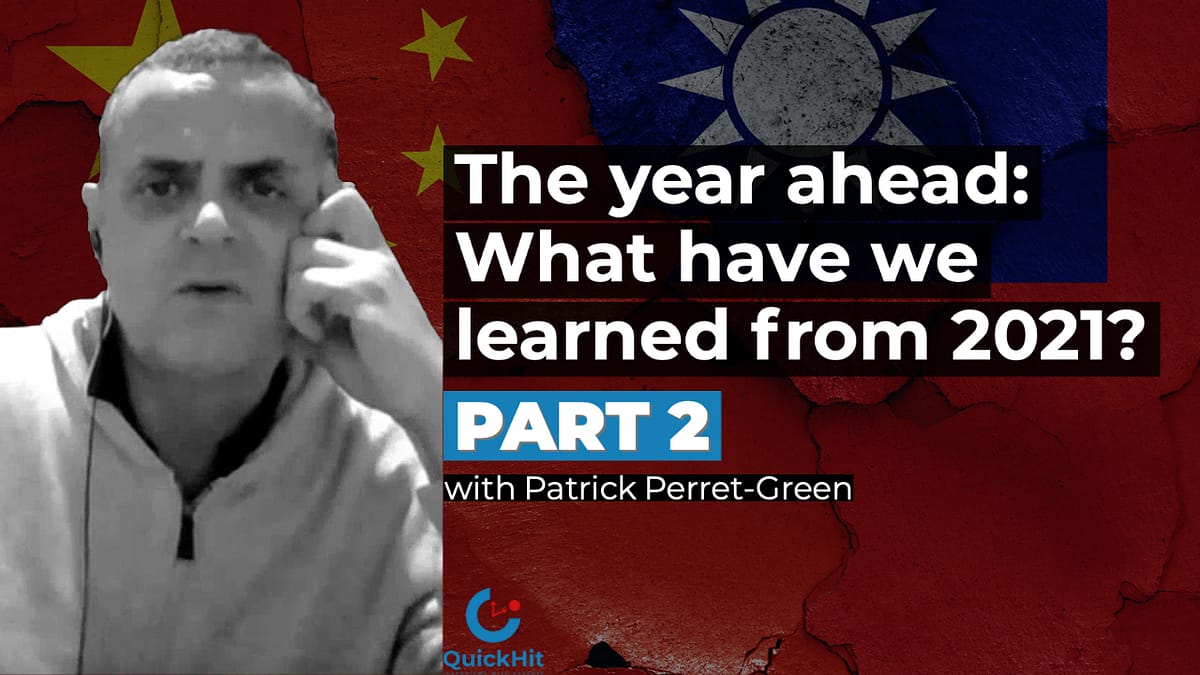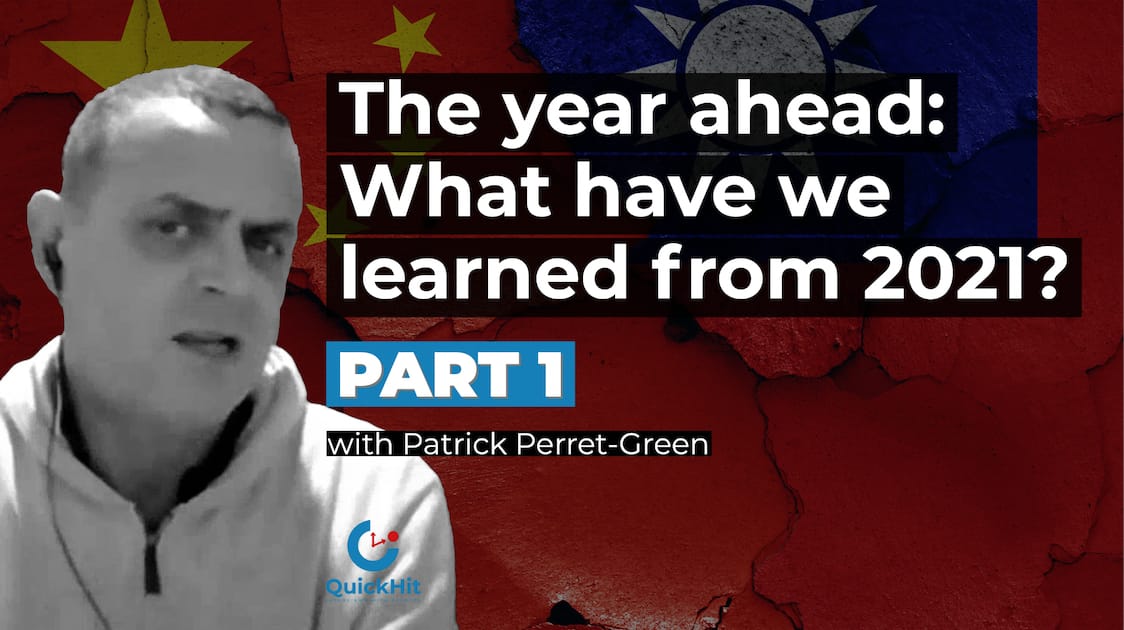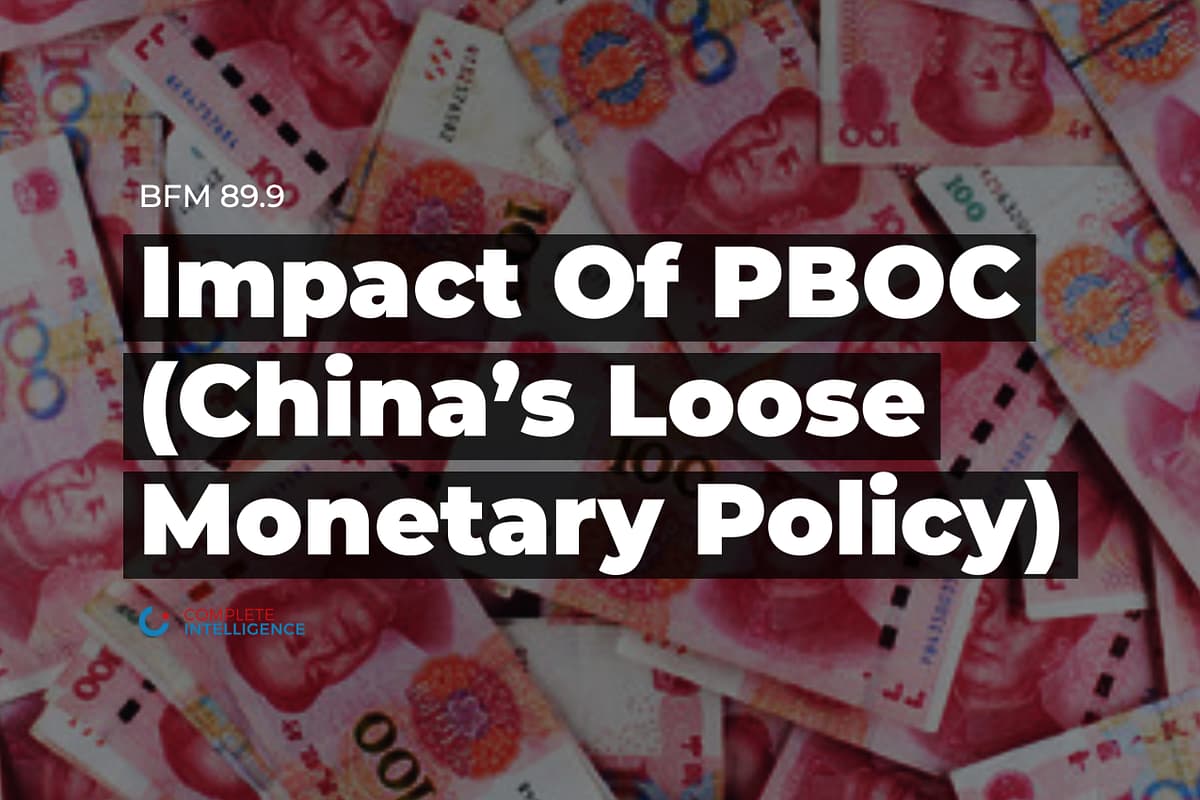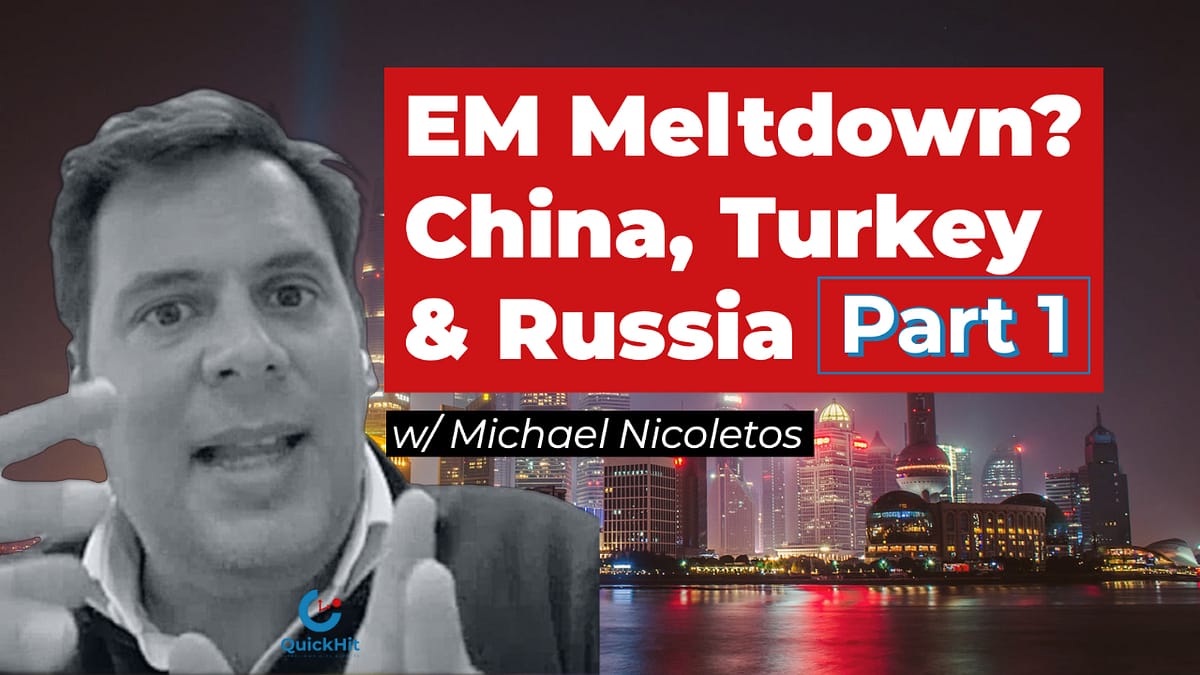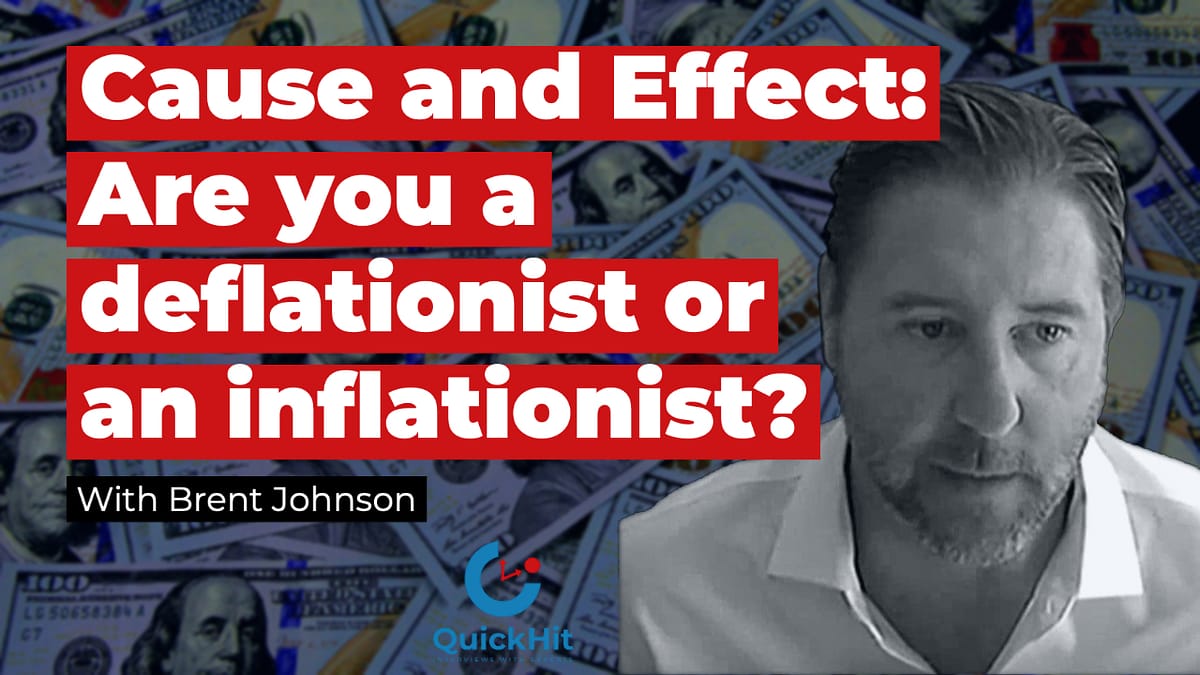This is the second episode of The Week Ahead in collaboration of Complete Intelligence with Intelligence Quarterly, where experts talk about the week that just happened and what will most likely happen in the coming week. Among the topics: industrial metals, energy markets, natural gas, China’s flood of liquidity and property market, CNY, and bond market.
You can also listen to this episode on Spotify:
Follow The Week Ahead experts on Twitter:
Tony: https://twitter.com/TonyNashNerd
Tracy: https://twitter.com/chigrl
Nick: https://twitter.com/nglinsman/
Albert: https://twitter.com/amlivemon
Show Notes
TN: Hi, everyone, and thanks for joining us for The Week Ahead. My name is Tony Nash. We’re with Tracy Shuchart, Nick Glinsman, and Albert Marko. To talk about the markets over this past week and what we’ve expect to see next week. Before we get started, please subscribe to our YouTube channel so you don’t miss any of the upcoming episodes.
So, guys, this week we saw kind of a whipsaw in equity and commodity markets with a slow start, but a lot of action mid week. And commodities seem to kind of extend gains until the end of the week. We saw bonds really wait until Friday to start taking off, but they took off quite a bit today. And part of that may have been on the back of the retail sales print that we saw. That was pretty disappointing. So, Tracy, do you want to kick us off a little bit with talking about commodity markets and energy?
TS: Sure. I mean, obviously, we’ve seen a big push in the oil market. Right, in WTI and Brent this week. We’re definitely a bit overbought. But that said, what I think is happening here is we’re seeing a shift from sort of growth to value. I think the markets are pricing in the fact that OMA crime is over. Right. And the Fed may raise rates. That’s putting pressure on growth and giving kind of a boost to the value market. And we’re kind of seeing a chase here a little bit in the oil markets.
As far as if we look at the natural gas markets, it’s been very volatile this week, not only in the US, but global markets. I think that will continue. And we saw a big push up on Wednesday, and then we saw a big pullback, but that was due to weather. But now we’re looking at this weekend, we’re having another cold front. And part of that reason was also because we discovered that Germany had less natural gas in storage than initially thought. So that market, I definitely think it’s going to continue to be very volatile. So try lightly in that market there’s.
TN: You mentioned the Germany supply side of the market, but what does supplies look like, say in the US and other parts of Europe? Are supplies normal? Are they low? What is that dynamic?
TS: Yeah, we’re pretty much normal in the US, and we’re set to in this year. We’re set to pretty much overtake the market as far as the export market is concerned. That would mean taking over Australia and Qatar because of the amount that we’re building out in the delivery system in Texas. But the supplies here are okay. The problem is within the United States is that the distribution is uneven.
So you’re talking about the Northeast, where you’re seeing local natural gas prices a lot higher there. Then you’re seeing, say, in Henry Hub, which is the natural gas product that trade that you’re trading.
TN: So I saw some just to get a little bit specific on this. I saw some news today about some potential brownouts in, say, New York or something because of this winter storm. How prevalent will that be? Maybe not just say, this weekend going next week, but for the rest of the winter. Are the supply problems that extreme?
TS: Yeah, I think you’re going to have a lot of problems in the Northeast. And I’ve been alluding to this over the last few months saying that they have decided not to go ahead with pipelines. They’ve shut pipelines. They kind of cut off their supply because they don’t really want to pursue that Avenue anymore.
However, it’s turning out to be a particularly cold winter, and that’s a lot of pressure on that market. And that’s why we’re seeing $11 natural gas prices up in that area as opposed to $4 in Henry Hub.
TN: Right. Meantime, Albert’s warm down in Florida, right.
AM: Yeah. Well, I wanted to ask Tracy what happens if we have an extended winter where the winter temperatures go into late March or early April.
TS: Then that’s extremely bullish. That’ll be extremely bullish for domestic supplies because domestic supplies will be in higher demand than they are normally seasonally, especially at a time where we’re a giant exporter right now.
We just came to save the day in Europe with 52 now cargo. So we’re exporting a lot if we have an expanded winter here. Supplies are unevenly distributed. We’re going to see I think we’ll see higher prices in out months that we normally see a pullback in those markets.
TN: Great. Texas, thanks you for those cargo, by the way. We really appreciate it. Okay. What about the broader commodity complex? What are we seeing on, say, industrial metals and precious metals?
TS: So obviously, those have been very bullish are going to continue to be bullish because they’re in deficit. As far as if we’re talking about battery metals and such, I think we’ll continue to see that we’re seeing a little bit in the platinum markets. We’re seeing some demand. I think there’s going to be bigger demand this year.
TN: So we’ll show some platinum on screen here so our viewers can see kind of where the platinum price is and where it’s expected to go.
TS: Yeah. So platinum demands expected to grow because of the automobile markets and because of Palladium is so high they can substitute platinum for that. But that may be capped for the rest of the year, and then we may continue to see higher prices going into 2023.
TN: Okay. So when you say that’s growing because of automotive, is this growth in ice ice vehicles. Okay. And is that happening because and I don’t mean these leading questions, but is that happening because the chip shortage is alleviating and we’re having more manufacturing in ice vehicles?
TS: I mean, that’s part of it. But platinum is used for catalytic inverters Palladium. And because of the fact that there’s platinum happens to be a lot less expensive. Right now. And also there’s more of it right now. So we’re seeing kind of demand pulled to the platinum industry. And I’ve kind of been worrying about this for the last couple of years that this was going to happen.
And now we’re kind of seen that comes to fruition because it takes a couple of years to retool and everything to sort of switch that metal. So I think demand looks good right now for that. We may see it capped a little bit. That may go up again. But if we look at this chart, technically speaking, I would say anywhere between 1005 a 1010. If we kind of Zoom above that, then that market could go a lot higher.
TN: Right. So short term opportunities in platinum, medium term, not so much, but longer term back in.
TS: Yes.
TN: Okay, great. Now when you talk about industrial metals like copper and you say a lot is needed for batteries, these sorts of things, that’s a more medium, longer term term opportunity. Is that right?
TS: Absolutely. When you’re talking about things, I mean, we’re already seeing the nickel market, cobalt market, lithium market, aluminum markets all hitting new highs. Copper’s kind of waffling about. But that’s kind of more a marathon trade rather than a sprint trade, in my opinion. So I think we’re going to see more and more demand for that further out in the market. So it’s kind of a longer term investment.
TN: Okay, great. And then what about industrial metals demand in China? As we switch to talk about a China topic, are we seeing industrial metals demand rise in China, or is it still kind of stumbling along and it’s recovery.
TS: That is still kind of stumbling along. And so what I have said before try to emphasize is that I think a lot of these battery metals in particular demand is going to go going to be outside of China.
China won’t be the main driver of this demand anymore as the west policies want to change to EVs and greener technology. So I think you’re going to start seeing very much increased demand for the west. So China demand might not be as significant anymore in that particular area.
TN: Okay. So that’s interesting. You mentioned China demand, Dink and Albert, I’m interested in your view on that. We had the Fed come out last week and talk about tightening and reinforced some of that this week. What dynamic is necessary in China, if anything, for the Fed to start tightening?
AM: Well, I think first of all, Tony, China is going to have to stimulate. They’re starting to prioritize growth for the first time in a long time. They see the US in a bit in a little bit of trouble here with the Fed making policy errors. I don’t want to say heirs. We’re more about like throwing together against the wall and see what works. Right.
So China is trying to be the seesaw for the world’s finance sector. Money comes into the United States it goes out. Where is it going to go? It’s either Europe or China. Europe right now is a complete mess. So obviously you see that money going into China you will keep on leaning on businesses and look to control more than you should but they’re breaking up a lot of the old power structures and that’s actually bullish long term for China. We can debate many of these episodes that we’re doing now, Tony, about whether it’s a good or bad thing for the China power structure. But that’s for another day.
TN: Right. What kind of stimulus if we look at things like loan demand so we’ll put up that chart on loan demand. Can you talk us through can you talk us through the chart of what it means and what the PPO will likely do as a result of low demand or consumer credit? Sorry.
NG: Yeah, the credit impulse so that’s private sector lending as a percentage of GDP and that chart shows it may have based and that looks like what we’ve been hearing is that the PBOC has been encouraging the private sector to start extending credit into the system, particularly to find off the real estate market which is not a surprise.
My personal view and some of the people that I talked to on China is that’s just filling a hole. This is plugging holes or putting plasters on various holes. So what will be interesting is to see how that progresses further down the line along this year. I don’t think nothing’s going to happen before February 1, lunar new year and then you’re running into that plenum. Do they encourage that you’ve got the Olympics and then you’ve got the plenum? Do they encourage some sort of boost?
I don’t think there’s going to be much fiscal. I think there’s a reason for that. I think there’s a connection with the real estate sector. Real estate sector. As a source of great funding for the local governments.
TN: They spend fiscal on bailing out real estate already. Why would…
NG: You have to provide fiscal to the local governments just for the services?
TN: Right. So the central party meetings are in November, so there’s plenty of time between Lunar New Year and November to really tick off some monetary stimulus and get some feel good factor in, say, Q three or something. Is that what you’re thinking?
NG: There is a desire, as Albert rightly said, they are talking about the economy now, but it just feels like it’s one plug the bad, the big holes that have been appearing and they just keep appearing and now we’ve got Shamal. It just seems like it’s step by step plug every hole and then give a little bit of access to try and get the private credit rolling again.
AM: Tony, everybody is looking for a flood. When is the flood of liquidity going to come into China? Right. But that’s not going to happen until May or June until they see what the US Fed is going to do because nobody right now knows what the Fed is going to do.
Inflation is obviously a problem within China, specifically oil and other commodities, as Tracy was talking about. Their eyes are completely on the Fed. China will have to pop services sector as a real economy. It’s kind of a shambles there due to commodity prices and inflation.
The willingness is there to lend. There’s no question about that. But who wants property right now in China? They can force feed the economy via credit. But that’s inflationary also. So there’s another do move here within China. How do they boost their economy but still keep inflation down? Same thing the United States is going through. Okay.
TN: So let me give you a really simple trick here.
NG: Let’s not forget you’re seeing some majors. Shanghai now has Omikaron. Remember, China, supposedly, according to the World Health Organization, didn’t suffer the first route, but you got Dahlin is closed, Nimboa’s got problems now Shanghai, Shenzhen, and they’re worried it’s going to head up towards Beijing.
All these international flights to Hong Kong completely canceled. So that’s another problem if you extrapolate and equate it to what’s happened in the west whenever these outbreaks have occurred.
TN: Yeah, but I think the solution. Yeah, that’s a problem. I think everybody’s facing that and I think China is just very, very sensitive about that. We can come up with whatever kind of conspiracy theories we want about China, but I just really think that they’re very embarrassed by COVID and they’re trying to cover things up, not cover up, but they’re trying to offset the negative preconceptions globally by taking dramatic action at home. That’s my view.
TS: And they have Chinese New Year and the Olympics coming up, right?
TN: Yeah. And they’re being very careful about that now. My view for quite some time has been that they would keep the CNY strong until after Lunar New Year and after Lunar New Year, they could get some easy economic gains by weakening CNY just a bit. Is that fair?
AM: I think it’s fair. They don’t want the bottom to fall out of the economy. And the extent of their damage the extent of damage to the economy was pretty significant. So they’re going to have to pull off a few tricks. Like you said.
TN: It’s percentage wise, it’s a lot. But in reality, at 65667 CNY historically, it’s nothing compared to where that currency has been historically. And I think it’s pretty easy to devalue to that level. And I think they would get some real economic gain from that.
AM: Yeah. But again, it matters what the Feds are going to do with rate hikes. That’s the wild card.
NG: The devaluation not just look at the dollar, look at the CFA, because I think it pays them to value against the Euro more than the dollar.
TN: Yeah. Okay. We can have a long talk about the CFO’s basket at some point.
NG: My point is you got to look at the Euro CNY as well as the US, because I think that’s where they’ll go.
TN: Yeah. Okay. So does this present an opportunity for Chinese equities in the near term, or is it pushed off until Q two?
AM: I mean, from my perspective, I’ve been on Twitter saying that I’ve gotten into Chinese equities. They are de facto put on the US market, in my opinion. They don’t have the strength of the actual but does. But money has got to flow somewhere, and if it’s not going to the United States. It’s going to go to China.
TN: Okay. All right. Let’s move on to bonds. Okay. Nick, can you cover bonds and tell us are we on track? Are things happening as you expected? Do markets do bonds like what the Fed has been saying? What’s happening there?
NG: Well, the initial reaction after the testimony from Powell was you had a steadying and a slight rally in bond prices, slightly slower yields. But I thought today was fascinating because today we’ve across the York Cove. We’ve made new highs for the move, so we’re at the highest yield for the last year.
What was interesting is we had that disappointing retail sales. Okay. That would typically suggest if this Fed is sensitive on the economy, perhaps they won’t do much. Well, the bond market didn’t like that. So now you have what is typically good news for the bond market, creating a sell off. And that tells me that the bond market is beginning, especially with the yield curve. Stevening, the bond market is beginning to express more anything that suggests that the Fed doesn’t do what they’re talking about. The market wants to see action. Not words.
TN: We’re getting punished for now.
NG: And what’s interesting is if you think a little bit further forward, if the Fed does hold back and isn’t as aggressive as some of the governors have been suggesting, three to four hikes I didn’t think Ms. Bond Mark is going to like that.
TN: Or Jamie Diamond saying eleven heights.
AM: Jamie diamond is nothing that comes out of his mouth should be taken at face value. Him knocking the 30 year bonds down today, he’s just setting himself up to buy. I mean, the guys he talks his book always has.
TN: Hey, before we move on, before we move on to talking about next week, we did get a question from Twitter from @garyhaubold “Does the FOMC raise rates at the March meeting? And how much does the S&P500 have to decline before they employ the Powell put and walk back their lofty tapering and tightening goals” in 20 seconds or less going, Albert? Oh, 20 seconds or less.
AM: Well, the market needs to get down to at least the 4400, if not the 43 hundreds. That’s got to be done in a violent manner. And it has to put pressure on Congress to do it. And they can’t raise rates unless they get at least $2 trillion in stimulus.
NG: And also don’t forget the Cr expires on February 18. So we could be in the midst of a fiscal cliff.
TN: February 18. Okay. We’ll all be sitting at the edge of our seat waiting for that. Okay. So week ahead, what do you guys think? Albert, what are you seeing next week?
AM: Opec pump for Tuesday and then Biden dump for Wednesday as they set up a build back better push in Congress, along with probably a hybrid stimulus bill to try to get to that $2 trillion Mark. Otherwise, they got no fiscal and this market is going to be in some serious trouble.
TN: Okay. Can they do it? Can they do some sort of BBB hybrid?
AM: Yeah, they can do it. They can get ten Republicans on board as long as there’s a small business, small and medium sized business stimulus program. Okay. They’ll get that.
TN: And if they do market react and you say that’s $2 trillion. You say that’s…
AM: They need a minimum of 2 trillion to be able to even think about raising rates in March.
TN: Okay. And Nick, how does it matter?
AM: This is dependent on how bad inflation actually gets, because if we get an 8% print of inflation next month. Then everything is on the table.
TN: So can you say that you cut out just a little bit if we get what, an 8% print?
AM: If we get an 8% print on CPI the next time around and anything is on the table.
NG: Okay. I think what was happening with the bond market basically is it’s beginning to look a little bit longer term. And I’ve had this conversation, the big traders, the big fund managers are sitting there thinking, okay, look at crude oil now, 85 on Brent. Energy price is crazy in Europe.
That’s going to feed through from the wholesale level all the way through to the consumer via manufacturing goods, via the housing market, via service industries. Starbucks has to charge some more because they’ve got a much bigger overhead.
TN: Netflix just raised their prices by a buck 50 or $2 a month or something.
TS: Filters down to everything. Energy runs the world, right? So that’s going to higher energy prices are going to factor into literally everything you do.
NG: And my personal view, I think that sort of works is in sync with Tracy. I think crude goes a lot higher. I think this year we could see north of 100, perhaps as high as 120. This all feeds through, right? So the point is the bond market there’s a lot of conversations on a longer term plane right now. And the bond market is an expression if it’s higher yields, yield curves deepening.
Anything that says that the fed is hesitant, I think you get sent off. I think that’s why we sold off. We should have been running on week retail sales.
TN: Okay, Nick. Sorry. If we do get a $2 trillion bill, what’s going to happen with bonds?
NG: They’ll be sold.
TN: They’ll be sold. Okay. So they’re going to punish the fed if we get fiscal?
NG: They’ll punish the fiscal fed to start acting and acting in short order. And I remain unconvinced. We’ve only heard words. We got to see the action. They’re still doing. Qe. Right? It’s absurd.
TN: Yes. We’re going to keep the flow going over here, but we’re going to raise interest rates over here. I’m not sure I get it. There’s been that disconnect ever since they announced this in December.
Okay, guys. Thank you very much. We’ve hit our time. Have a great week ahead and we’ll see you next week. Thank you very much.
AM, TS, NG: Thank you. Bye.


